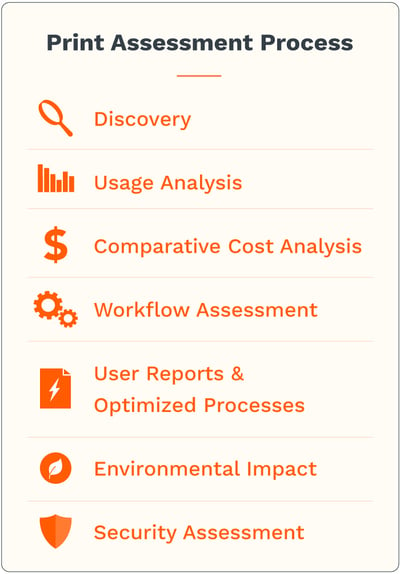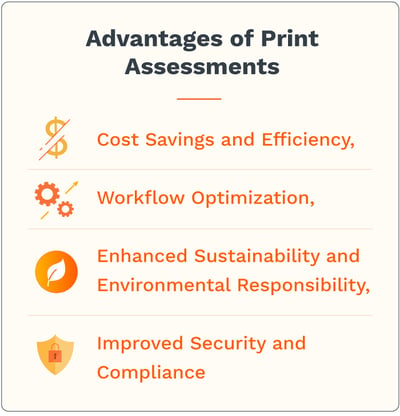How many pages does your company print each week? What are your current print costs? What's the total cost of ownership? Are your reactive processes hindering productivity? If you don't know the exact print volumes or expenses, you're not alone.
Optimizing enterprise print environments is a business imperative in today's fast-paced, hyper-digitized world. It's key to ensuring efficiency, controlling costs, and improving productivity.
Engaging in a professional print assessment and analysis is vital to better understand an organization's print environment and related costs. By partnering with a Managed Print Services or MPS provider, businesses can quickly understand the different variables that impact printing costs, streamline fleets, reduce expenses, and maximize efficiency.
A comprehensive print cost & workflow analysis supported by MPS consulting can help unlock the full potential of the printer fleets and enhance the overall print management strategy. This comprehensive guide will delve into print assessment and analysis, its importance, benefits, and potential to positively impact your bottom line.
Before diving into print assessments and analysis, it’s important to understand what MPS is and why it’s important.
What are Managed Print Services?
MPS is a print-related service offered by an external provider to optimize or manage an organization's document output. Key components of MPS include detailed assessments, selective or complete hardware replacement, both physical and software related operational and maintenance services, workflow optimization, security, and parts and print supplies that help minimize downtime and ensure business continuity.
MPS providers also monitor how office printers and copiers are being used, identify potential issues, and look for opportunities to boost user experiences & overall productivity.
Why Is Managed Print Services Consulting Important?
MPS consulting plays a crucial role in the print assessment and analysis process because MPS consultants specialize in optimizing print environments for businesses and provide expert guidance. They leverage their in-depth knowledge of industry best practices to help organizations achieve their print management goals.
During an MPS assessment, print assessment consultants work closely with an organization to understand their unique printing needs and recommend or customize unique print solutions to enhance productivity, reduce costs, and improve sustainability.
Understanding Print Assessment and Analysis
The next step in this process is understanding what a print assessment and analysis is and how it can be applied.
What Is a Print Assessment?
A print assessment is just what it sounds like. It systematically evaluates an organization's print environment to gather valuable data and insights to optimize print-related processes. It comprehensively examines enterprise print infrastructure, including hardware, software, document workflows, and print-related expenses.

A typical print assessment process is as follows:
- Discovery phase: This is the initial phase where print assessment consultants will physically walkthrough and collect data from all devices connected to the enterprise network. In this scenario, the assessor or assessment team will collect data about the make and model of the devices, their location, user details, network settings, print volumes, and so on.
- Usage analysis: The next step is to perform a volume and usage analysis of these print devices. This involves collecting data on individual print volumes, type of ink or toner used (color vs. black and white), type of usage (print, scan, copy, and fax volumes), etc.
- Comparative cost analysis: How efficient is each device compared to other devices in the office? The assessor can calculate the total cost of ownership from the collected usage data. This also includes direct costs such as consumables, maintenance, and print equipment costs and indirect costs such as IT support, infrastructure, and employee productivity.
- Workflow assessment: This step involves understanding the workflow related to print operations within the organization. It considers how documents are created, shared, stored, and managed. This helps identify areas that can be improved and potential opportunities for digitization or automation.
- User reports and optimized processes: By assessing user behavior in the organization's print environment, the print assessment consultant can ascertain how a new printer infrastructure can help improve print workflows.
- Environmental impact: It's also important to evaluate the overall environmental impact of the current print infrastructure. In this scenario, it's essential to consider factors like power consumption, waste generation, and carbon footprints.
- Security assessment: Finally, a security assessment is necessary as print environments are often a weak point when it comes to IT security. A print assessment will help shed light on the security of print data, access control, compliance issues, and potential risks.
After the print assessment and analysis, companies typically receive a comprehensive report detailing the findings and improvement recommendations. By conducting a comprehensive print assessment, businesses can gain a holistic view of their print environment, identify potential opportunities for improvement, and formulate data-driven strategies for enhanced print and device management.
What Is the Significance of a Print Cost Analysis?
A print cost analysis is a critical component of the print assessment process. However, it's not all black and white. A comprehensive price cost analysis encompasses an in-depth inspection of the costs associated with your print fleet, including printing devices, consumables, maintenance, current processes and workflows, as well as energy consumption.
A printing cost calculator will provide the true cost of business printing and their associated workflows. For example, businesses must look at the overall cost of printing, cost per page, individual ink cartridge costs (like cyan, magenta, and black ink), and how the machines are used across the companies tech eco-system.
By engaging in a comprehensive print cost analysis, organizations can identify inefficiencies, shortcomings in workflows, eliminate unnecessary expenses, and implement cost-saving measures by analyzing print costs. This approach empowers office administrators to make informed decisions, streamline print-related expenses, boost productivity, implement new technologies, and allocate resources more effectively. When all this comes together, it will positively impact your bottom line.
Key Advantages of Print Assessment and Analysis
There are several benefits to engaging in a comprehensive print assessment and analysis. Some print assessment and analysis advantages include the following:

Cost Savings and Efficiency
One of the key advantages of conducting a print assessment and analysis is identifying potential areas that can enable significant cost savings. By recognizing processes that lead to wasteful spending, companies can formulate and implement optimized print strategies to reduce print-related expenses considerably.
Proactive monitoring and management help reduce unnecessary printing. This approach will help IT departments or IT staff determine avoidable paper, toner cartridges, and energy consumption. At the same time, enterprises can also enhance productivity and overall operational efficiency by streamlining print workflows and deploying efficient print devices.
Workflow Optimization
Print assessments can help optimize workflows and improve any print-related process. This approach also helps boost productivity, reduce costs, and enhance efficiency.
A print assessment and analysis can quickly identify bottlenecks or inefficiencies that may slow down the process. For example, unnecessary steps or the use of legacy equipment. Businesses can only streamline workflows once these have been identified and addressed.
These assessments can also help prioritize tasks based on their importance. Organizations can improve time management by prioritizing tasks and ensuring that the most critical tasks are completed first.
Enhanced Sustainability and Environmental Responsibility
Print assessment and analysis can optimize sustainability efforts and help businesses reduce their carbon footprint. Organizations can also promote paperless initiatives and minimize their environmental impact by optimizing print environments for reduced waste and energy consumption. For example, companies can implement features like duplex printing, print quotas, and digital workflows.
Improved Security and Compliance
In the current threat landscape, robust cybersecurity is critical to business relevance. A comprehensive print assessment can help identify print infrastructure vulnerabilities and implement robust security measures. Enterprises can also mitigate risks and ensure compliance with data protection regulations by adopting secure print solutions and best practices, such as user authentication and document encryption.
Key Disadvantages of Print Assessment and Analysis
Although a print assessment and analysis comes with some critical benefits, several key disadvantages are also associated with this approach. Some of these disadvantages include the following:
Lack of Interactivity and Engagement
Some printing resources, like materials, are static and lack the interactive elements we have grown accustomed to. As such, this limitation can be a significant hurdle to print assessment and analysis as it's challenging to quickly measure metrics like user engagement, which includes clicks, shares, or comments. Interactivity is a vital component of modern media consumption, and print analysis alone may not adequately capture this engagement.
Time and Resource-Intensive
Depending on the organization's size, print assessments can sometimes require a considerable amount of time and resources to complete. This is because each printer, copier, and system on the network must be examined and analyzed individually.
Print Fleet Optimization Strategies
Print fleet optimization strategies strive to streamline printing processes and boost efficiency. Enterprises can reduce costs, improve productivity, and minimize environmental impact by implementing customized strategies.
After an organization implements all recommendations, it can expect to see significant improvements and real value across various areas. The most obvious are cost savings through lower energy consumption, reduced ink and paper usage, and reduced maintenance costs.
Implementing the security recommendations not only protects the organization's sensitive information (reducing the risk of data breaches or leaks), but it can also help ensure compliance with data protection regulations. This translates into cost savings in the long term.
Streamlined processes, automation, and digitization lead to optimized workflows, increased employee productivity, and overall operational efficiency. Businesses will also benefit from predictable expenses and improved device management, making budgeting more straightforward and accurate. The insights gained from the print assessments help organizations make better decisions about their print infrastructure and policies. This approach can also consistently improve print operations over time.
It's important to note that the value and benefits of a print assessment and analysis will be realized over a period of time. It can take time to fully implement these changes. It can also take some time and effort for staff to adapt to new processes and workflows. Monitoring and management will also be necessary to sustain these benefits over the long term.
It’s important to discuss regular reassessments with your MPS provider. This is because reassessments enable continuous improvement. This approach can help companies stay informed about emerging print technologies and trends that can ensure that organizations remain at the forefront of efficient print management.
Categories: Security, Document Management, Sustainability, Document Imaging, Strategy, MPS, Ricoh, IT Management, Printing Solutions, Managed Print Services, Copier, Printer, Managed Printer Services, Imaging, IT, Assessment, Kyocera, Sharp











